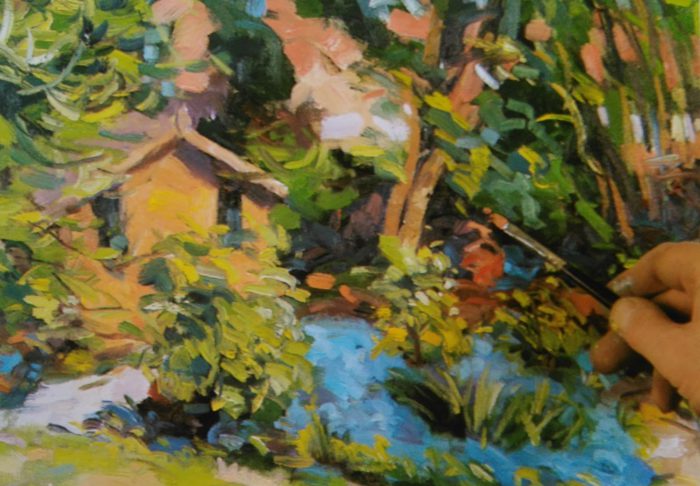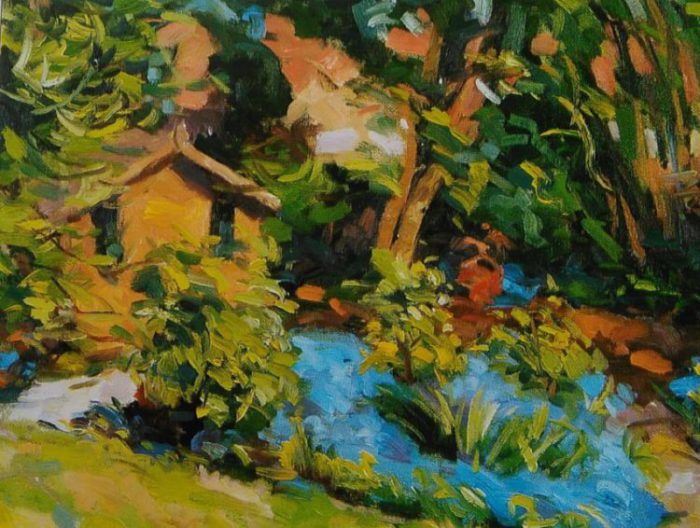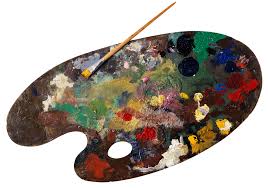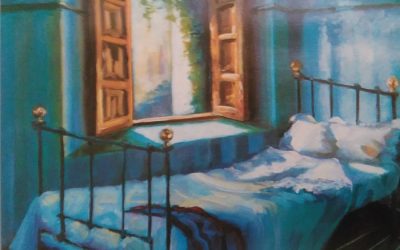When oil color is intentionally added in thick layers so it has visible brush strokes and ridges that is called impasto painting technique. This technique is often used in painting Alla Prima. Three dimensional quality of the impasto technique is used for forming and even mimicking the texture of a certain object.
Impasto can be used only in certain areas of the painting or the entire painting can be done in this manner to express the lively surface full of energy. It can be done with a brush or a palette knife. Paint has to be buttery and can be used directly out of the tube or with a little bit of turpentine or oil added so it is stretchy but still thick enough so it can maintain the shape.
Hog bristle brushes are the best for this technique because they hold a lot of paint. Ad paint to the canvas with bold moves in all directions to get the effect of a luscious texture. The impasto painting technique is one of my favourite techniques in oil painting and I always use brushes for it.

Spring Garden
To paint this you will need the following:
- Primmed canvas
- Filbert hog bristle brush number 4
- Flat hog bristle brush number 5
- Round hog bristle brush number 2
- Flat sable bristle brush number 4
- Odourless mineral spirits
- Linseed oil
- Charcoal
- Clean Rag
And the following colors: Chrome Green, French
Ultramarine, Manganese Blue, Ochre Yellow, Spectrum Yellow, Lemon Yellow, Cobalt Purple, Cadmium Red and Titanium White.
Sketch the main contour of the composition using charcoal.
Use the clean rag to wipe off the residue from the charcoal in order to prevent it to smudge the oil colors when mixing with them.
When the subject is so vivid its always better to do the underlayer in order to determine large surfaces.
This will be very useful when you start adding the layers of paint.
Dilute the paint with mineral spirits to get it thin and transparent and apply it on the canvas using hog bristle filbert brush number 4.
Use Chrome Green for the yellowish-green grass in the front plane and for the purple flowers use the combination of French Ultramarine and Manganese Blue. Soft tones of the shed are gained with Spectre Yellow and Ochre Yellow.
The trees and bushes are painted with Chrome Green, Cobalt Purple, Ochre Yellow and a little bit of Cadmium Red. Step away from the painting to asses the composition. Leave it to dry.



Building The Composition
Start adding the paint on the darkest areas of the painting. Use thick paint adding just a little bit of mineral spirits and linseed oil to make it creamy.
For the darkest tones on the trees and windows use the mixture of Cobalt Purple, French Ultramarine and Chrome Green.
Use pure Chrome Green for the lighter, warmer tones on the leaves where the sunlight goes through the treetops.
Paint the shadow under the roof of the shed with the mixture of Cobalt Purple and Cadmium Red.
Twist and turn the paintbrush while you are painting to
create a strain of interesting traces and textures and give the painting a sense of movement.
Do not try to finish any part of the painting before the other. Go through your painting adding the paint simultaneously.
Add some spots of warm paint on the trees and bushes to create the impression of warm sunlight. Mix Cobalt Purple, Cadmium Red and a little bit of Titanium White and add the paint with bold brush strokes.
Do not get tempted to blend the edges of the strokes with the surrounding paint. To create brighter tones of the shed mix Cadmium Red, Spectra Yellow and Titanium White to gain warm orange.
Use flat hog bristle brush number 5 to add thick layers of paint with visible brushstrokes in them. Move the brush in every direction to create different paint patterns and vary with the ratio of the colours in the spread to create the impression of flickering light adding more yellow or more white for the lightest areas. For the roof of the shed use Cobalt Purple and Titanium White.

Adding The Details
Mix French Ultramarine with Chrome Green and with relaxed moves determine the shapes of the trees in the background don’t minding the details.
For the glimpse of the buildings in the distance that you can barely see of the trees use the mixture of Cadmium Red and white to gain warm pink.
Add a bit more white and Ochre Yellow to the mixture and use it to add spots of light within the trees and finish the stomp of the main tree.
Mix Ochre Yellow, Cobalt Purple and white to get the warm tone of the path that goes along the garden. Wash the brushes with odourless mineral spirits and wipe them with the rag. Use the mixture of white and Manganese Blue for blue flowers. Paint with bold moves using thick paint.
To create the impression of flickering light add a little bit of French Ultramarine to the mixture and apply it on several shady areas.
Make the mixture a little bit darker with a bit of Cobalt Purple and use it to paint the blue flowers in the shade of the trees in the back end of the painting.



Finishing Touches
Start defining the shape of leaves. Mix Chrome Green, French Ultramarine and a bit of white for cold middle tones on the trees on the right side of the painting.
Depict the cluster of leaves in the treetops with wide moves using the flat brush number 5. The thick paint will give the structure and shape to the treetops when it is added in a strain of short swift moves.
For the grass in the front plane mix Chrome Green, Lemon Yello and white. Vary in the ratio in order to gain lighter and darker tones to depict shimmering light.
Add a lot of Lemon Yellow to the same mixture and use it to pain the leaves around the shed. Paint with short curvy moves using round hog bristle brush number 2.
Add a little bit of Ultramarine to the mixture to provide tone contrast. Paint the sky in the distance with the mixture of ultramarine and white.
Mix Ochre Yellow, Spectre Yellow and white to paint the patches of bare land in the grass. To create the cold green in the shadows mix Chrome Green, Titanium White and French Ultramarine. Add that paint whit flat brush number 5.
Then mix light, warm green using Lemon Yellow, Chrome Green and Titanium White and paint the parts of the leaves when the sun shines the brightest with short moves and little spots using round hog bristle brush number 2 and sable bristle brush number 4.
Add a little bit of Cobalt Purple to the mixture and apply dots to the flowers in the shade of the trees. Mix Titanium White and Manganese Blue and ad spots to the brightest areas on the flowers.
Use lively brush strokes to paint the leaves in the middle of the painting and to create the impression of sunlight going through the treetops.
Make the color of the brightest areas a bit warmer adding some Cadmium Red, Spectre Yellow and Ochre Yellow here and there.
Look at your painting from the distance. Then add every finishing move you think is needed. Maybe add some spots of warm color to freshen up the painting or work on the details with specs of darker color.
Use the brushes of different sizes in order to give interesting structure to your painted surface with different sized spreads of paint.
When you are painting with oil colors and mixing a lot of them, your palette can become really dirty and the colors can get smudged. To avoid that clean the palette as often as you can.
If you have any questions regarding the subject feel free to leave them below in the comment section and I will be more than happy to answer them.





0 Comments